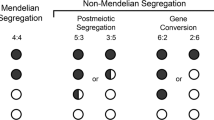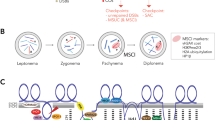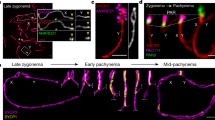Abstract
Nonhomologous meiotic co-orientation (NMC) was postulated for humans a half of century ago to explain the association between the presence of a rearranged chromosome(s) and the occurrence of aneuploidy for an unrelated chromosome (“interchromosomal effect”, ICE). However subsequent studies did not support meiotic nature of ICE phenomenon. At the same time, NMC model can be fruitful for solving a number of problems regarding the etiology of human aneuploidy. Published and own data on the offspring of 322 parental carrier of chromosomal abnormality were analyzed according to the carrier’s gender. In families with transmission of der(21;21), among patients with maternally derived trisomy 21 (T21), there is a typical male-biased sex ratio (SR), with 33 males/28 females. Among patients with paternally derived T21, five-fold male prevalence is observed (16 males/3 females), p = 0.0373. In families with maternal balanced non-contributing rearrangement (Rea), SR was male-biased among T21 patients, both those inherited (42 males/30 females) and not inherited the Rea (17 males/11 females). However, in families with paternal balanced Rea, there is an impressive difference between T21 offspring with transmitted paternal Rea and those not inherited paternal Rea, 49 males/21 females vs 4 males/15 females, p = 0.0003. A female predominance is also observed among non-trisomic offspring of paternal carriers of gonadal mosaicism for T21 (2 males/12 females), but not in non-trisomic offspring of maternal carriers (19 males/16 females), p = 0.0253. Unusual sex ratios in offspring of male carriers are considered as the result of NMC of a chromosome abnormality with the X chromosome operating in spermatogenesis.
This is a preview of subscription content, access via your institution
Access options
Subscribe to this journal
Receive 12 print issues and online access
$259.00 per year
only $21.58 per issue
Buy this article
- Purchase on Springer Link
- Instant access to full article PDF
Prices may be subject to local taxes which are calculated during checkout

Similar content being viewed by others
References
Grell R. Distributive pairing in man? Ann Genet. 1971;14:165–7.
Kovaleva NV. Distributive pairing of chromosomes and aneuploidy in man. Genetika (Russ). 1992;28:5–15.
Sun F, Oliver-Bonet M, Liehr T, Starke H, Turek P, Ko E, et al. Analysis of non-crossover bivalents in pachytene cells from 10 normal men. Hum Reprod. 2006;21:2335–9. https://doi.org/10.1093/humrep/del19
Kovaleva NV. Sex ratio in Down syndrome. Tsitol Genet. 2002;36:54–69.
Hassold T, Chiu D, Yamane JA. Parental origin of autosomal trisomies. Ann Hum Genet. 1984;48:129–44. https://doi.org/10.1111/j.1469-1809.1984.tb01008.x
Davidenkova EF, Butomo IV, Kovaleva NV. Parental origin of the extra chromosome 21 in families of children with Down syndrome. Genetika (Russ). 1988;24:1671–8.
Mikkelsen M, Poulsen H, Tommerup N. Genetic risk factors in human trisomy 21. Molecular and cytogenetic studies of non-disjunction. New York: Alan R. Liss, Inc; 1989. p. 187–97.
Petersen MB, Antonarakis SE, Hassold TJ, Freeman SB, Sherman SL, Avramopoulos D, et al. Paternal nondisjunction in trisomy 21: excess of male patients. Hum Mol Genet. 1993;2:1691–5. https://doi.org/10.1093/hmg/2.10.1691
Mikkelsen M, Hallberg A, Poulsen H, Frantzen M. Epidemiological study of Down’s syndrome in Denmark, incliding family studies of chromosomes and DNA markers. Dev Brain Dysfunc. 1995;8:4–12.
Griffin DK, Abruzzo MA, Millie EA, Feingold E, Hassold TJ. Sex ratio in normal and disomic sperm: evidence that the extra chromosome 21 preferentially segregates with the Y chromosome. Am J Hum Genet. 1996;59:1108–13.
Blanco J, Gabau E, Gómez D, Baena N, Guitart M, Egozcue J, et al. Chromosome 21 disomy in the spermatozoa of the fathers of children with trisomy 21, in a population with a high prevalence of Down syndrome: increased incidence in cases of paternal origin. Am J Hum Genet. 1998;63:1067–72. https://doi.org/10.1086/302058
Oliver TR, Bhise A, Eleanor Feingold E, Tinker S, Masse N, Sherman SL. Investigation of factors associated with paternal nondisjunction of chromosome 21. Am J Med Genet A. 2009;149A:1685–90. https://doi.org/10.1002/ajmg.a.32942
Kovaleva NV, Mutton DE. Nonhomologous meiotic co-orientation (NMC) in man. J Med Genet. 2005;42:68.
Borgaonkar DS. Repository of human chromosomal variants and anomalies. Thirteenth Listing. Newark, Delaware: The Medical Center of Delaware; 1990. p. 874.
Kovaleva NV. Sex-specific chromosome instability in early human development. Am J Med Genet A, 2005;136A:401–13.
Kovaleva NV. Increased risk of trisomy 21 among the offspring of the carriers of balanced autosomal rearrangements not involving chromosome 21, is not associated with interchromosomal effect. Russ J Genet. 2013;49:259–68. https://doi.org/10.7868/S0016675812110045
Miller DE. The interchromosomal effect: different meanings for different organisms. Genetics. 2020;216:621–31. https://doi.org/10.1534/genetics.120.303656
Alfarawati S, Fragouli E, Colls P, Wells D. Embryos of robertsonian translocation carriers exhibit a mitotic interchromosomal effect that enhances genetic instability during early development. PLoS Genet. 2012;8:e1003025 https://doi.org/10.1371/journal.pgen.1003025
Kovaleva NV. An overlooked phenomenon: female-biased sex ratio among carriers of robertsonian translocations detected in consecutive newborn studies. Russ J Genet. 2017;53:1444–52.
Daniel A, Hook EB, Wulf G. Risks of unbalanced progeny at amniocentesis to carriers of chromosome rearrangements: data from United States and Canadian laboratories. Am J Med Genet. 1989;33:14–53. https://doi.org/10.1002/ajmg.1320330105
Ghevaria H, Naja R, SenGupta S, Serhal P, Delhanty J. Meiotic outcome in two carriers of Y autosome reciprocal translocations: selective elimination of certain segregants. Mol Cytogenet. 2017;10:1 https://doi.org/10.1186/s13039-017-0303-y
Acknowledgements
The author is greatly indebted to Dr. Philip D. Cotter (ResearchDx, USA) for the helpful comments and amending English in this paper.
Author information
Authors and Affiliations
Corresponding author
Ethics declarations
Competing interests
The author declares no competing interests.
Additional information
Publisher’s note Springer Nature remains neutral with regard to jurisdictional claims in published maps and institutional affiliations.
Supplementary information
Rights and permissions
Springer Nature or its licensor (e.g. a society or other partner) holds exclusive rights to this article under a publishing agreement with the author(s) or other rightsholder(s); author self-archiving of the accepted manuscript version of this article is solely governed by the terms of such publishing agreement and applicable law.
About this article
Cite this article
Kovaleva, N.V. Evidence for nonhomologous meiotic coorientation in man. J Hum Genet 68, 333–337 (2023). https://doi.org/10.1038/s10038-023-01123-7
Received:
Revised:
Accepted:
Published:
Issue Date:
DOI: https://doi.org/10.1038/s10038-023-01123-7



